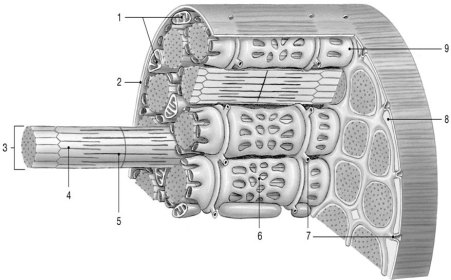A) release of neurotransmitter
B) conduction of the action potential into the cell interior
C) activity of acetylcholinesterase
D) release of protein and calcium ions into the muscle fiber
E) opening of sodium channels and subsequent influx of sodium
G) A) and C)
Correct Answer

verified
Correct Answer
verified
Multiple Choice
The region of the sarcomere that always contains thin filaments is the
A) Z line.
B) M line.
C) H band.
D) A band.
E) I band.
G) B) and D)
Correct Answer

verified
Correct Answer
verified
Multiple Choice
Synaptic vesicles contain neurotransmitters that are released by ________ when the action potential arrives.
A) endocytosis
B) apoptosis
C) exocytosis
D) hydrolysis
E) sodium
G) A) and D)
Correct Answer

verified
Correct Answer
verified
Multiple Choice
The type of contraction in which the muscle fibers do not shorten is called
A) tetany.
B) treppe.
C) concentric.
D) isotonic.
E) isometric.
G) A) and D)
Correct Answer

verified
Correct Answer
verified
Multiple Choice
Heat energy gained from muscle contraction is released by the ________ system.
A) integumentary
B) respiratory
C) cardiovascular
D) urinary
E) endocrine
G) All of the above
Correct Answer

verified
Correct Answer
verified
Multiple Choice
A(n) ________ can be described as a broad tendinous sheet.
A) fasciae
B) retinaculum
C) aponeurosis
D) interstitium
E) tympanum
G) A) and D)
Correct Answer

verified
C
Correct Answer
verified
Multiple Choice
The complex of a transverse tubule and two adjacent terminal cisternae is known as a
A) trimer.
B) triad.
C) triptych.
D) trisome.
E) trilogy.
G) C) and D)
Correct Answer

verified
Correct Answer
verified
Multiple Choice
Skeletal muscle fibers are formed from embryonic cells called
A) sarcomeres.
B) myofibrils.
C) myoblasts.
D) fascicles.
E) myomeres.
G) C) and D)
Correct Answer

verified
Correct Answer
verified
Multiple Choice
In rigor mortis
A) the myosin heads are attached to actin.
B) ATP is depleted.
C) calcium ions keep binding to troponin.
D) sustained contractions occur.
E) All of the answers are correct.
G) A) and C)
Correct Answer

verified
Correct Answer
verified
Multiple Choice
The cytoplasm of the neuromuscular terminal contains vesicles filled with molecules of the neurotransmitter
A) epinephrine.
B) norepinephrine.
C) acetylcholine.
D) antidiuretic hormone.
E) adrenaline.
G) A) and D)
Correct Answer

verified
Correct Answer
verified
Multiple Choice
How would the loss of acetylcholinesterase from the motor end plate affect skeletal muscle?
A) It would make the muscles less excitable.
B) It would produce muscle weakness.
C) It would cause muscles to stay contracted.
D) It would cause muscles to stay relaxed.
E) It would have little effect on skeletal muscles.
G) B) and C)
Correct Answer

verified
C
Correct Answer
verified
Multiple Choice
Active sites on the actin become available for binding after
A) actin binds to troponin.
B) troponin binds to tropomyosin.
C) calcium binds to troponin.
D) calcium binds to tropomyosin.
E) myosin binds to troponin.
G) B) and D)
Correct Answer

verified
Correct Answer
verified
Multiple Choice
Stem cells located between the endomysium and sarcolemma that function in the repair of damaged muscle tissue are called
A) myocytes.
B) satellite cells.
C) endocytes.
D) sarcocytes.
E) creatinocytes.
G) A) and E)
Correct Answer

verified
Correct Answer
verified
Multiple Choice
The bundle of collagen fibers at the end of a skeletal muscle that attaches the muscle to bone is called a(n)
A) fascicle.
B) tendon.
C) ligament.
D) epimysium.
E) myofibril.
G) A) and C)
Correct Answer

verified
Correct Answer
verified
Multiple Choice
Fast muscle fibers can adapt to aerobic metabolism by generating more mitochondria in response to
A) repeated,exhaustive stimulation.
B) sustained low levels of muscle activity.
C) high amounts of oxygen.
D) increased levels of testosterone.
E) prolonged periods of inactivity.
G) B) and D)
Correct Answer

verified
Correct Answer
verified
Multiple Choice
An infection by the bacterium Clostridium tetani can cause the disease called
A) cholera.
B) polio.
C) botulism.
D) tetanus.
E) muscular dystrophy.
G) A) and E)
Correct Answer

verified
Correct Answer
verified
Multiple Choice
The sequence of processes that links the action potential to contraction is called
A) neuromuscular junction.
B) action potential propagation.
C) excitation-contraction coupling.
D) cross bridge formation.
E) sliding filament theory.
G) A) and E)
Correct Answer

verified
Correct Answer
verified
Multiple Choice
A single contraction-relaxation cycle in a muscle fiber produces a(n)
A) cramp.
B) twitch.
C) tetanic contraction.
D) action potential.
E) motor unit.
G) B) and E)
Correct Answer

verified
B
Correct Answer
verified
Multiple Choice
 Figure 10-1 Skeletal Muscle Fiber
Use Figure 10-1 to answer the following questions:
-What is released from the structure labeled "9"?
Figure 10-1 Skeletal Muscle Fiber
Use Figure 10-1 to answer the following questions:
-What is released from the structure labeled "9"?
A) sarcoplasm
B) acetylcholine
C) protein
D) calcium ions
E) acetylcholinesterase
G) A) and E)
Correct Answer

verified
Correct Answer
verified
Multiple Choice
When acetylcholine binds to receptors at the motor end plate,the sarcolemma becomes
A) more permeable to sodium ions.
B) less permeable to sodium ions.
C) more permeable to calcium ions.
D) less permeable to potassium ions.
E) less permeable to potassium and sodium ions.
G) D) and E)
Correct Answer

verified
Correct Answer
verified
Showing 1 - 20 of 136
Related Exams